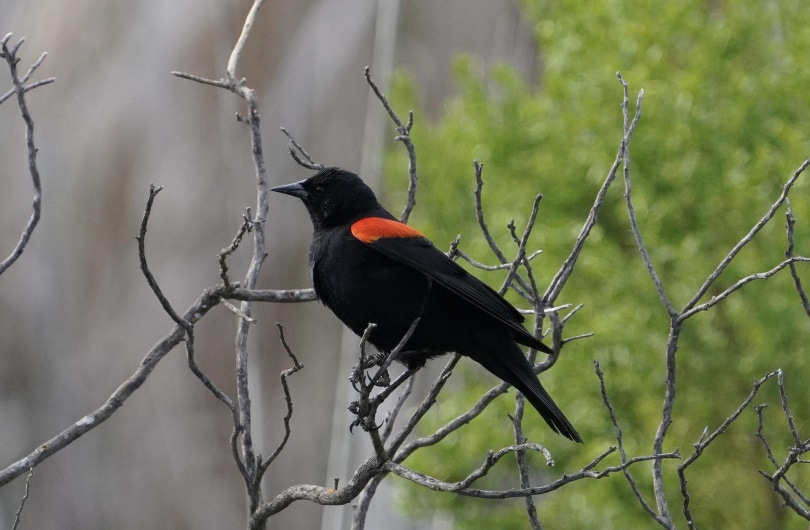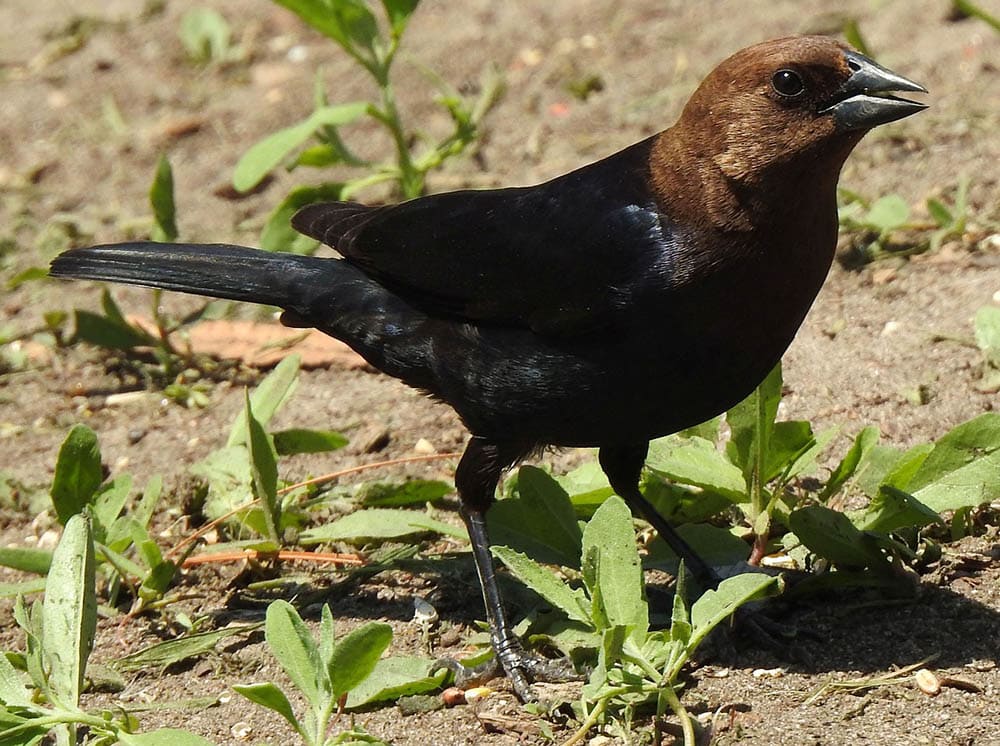12 Types of Black Birds in Louisiana (With Pictures)
Last Updated on

Not to be confused with a blackbird, which is a term limited to some birds within the family Icteridae, Louisiana is home to many black feathered birds, referring to their color. Louisiana has a sub-tropical climate that’s generally hot and humid in the summer and mild in the winter, but it hosts different ecosystems depending on where you are in the state. Some black birds may also reside in certain areas for a season, choosing to make their home in Central America or further north. With this guide as your resource, you can spot a beautiful black bird no matter where you are in the area depending on the time of year.

The 12 Types of Black Birds in Louisiana:
1. Red-winged Blackbird

| Scientific Name | Agelaius phoeniceus |
| Colors | Black, red, yellow, orange, brown |
| Wingspan | 2-15.8 in. |
| Length | 7-9.1 in. |
| Diet | Insects, seeds, and grains |
This black-colored bird is one of the only two species in Louisiana that’s truly a blackbird from the family Icteridae. Males are marked by mostly black feathers with a red and yellow-orange “badge” on their shoulder. Females differ dramatically from the males with a motley brown speckled body and striped feathers. They also have a red badge on their shoulder, although it isn’t as prominent.
The Red-winged Blackbird likes to reside in rural areas near standing water. They mostly eat insects that they find near the water and are known to scour aquatic plants for food. During the cooler months when bugs are scarce, you might find the Red-winged Blackbird eating seeds and grains such as sunflower, corn, and wheat seeds.
2. American Crow

| Scientific Name | Corvus brachyrhynchos |
| Colors | Black |
| Wingspan | 5-39.4 in. |
| Length | 8-20.9 in. |
| Diet | Omnivorous |
The American Crow can be found year-round almost anywhere in the United States, including Louisiana. One of the least picky birds, they live in the country and in the city, and they’ll eat pretty much anything they find. Seeds, worms, French fries, even baby birds stolen from other nests are all fair game. This all-black bird has glossy, sleek feathers, and a relatively big body that doesn’t differ noticeably between the sexes.
3. European Starling

| Scientific Name | Sturnus vulgaris |
| Colors | Purple-green, brown white |
| Wingspan | 2-15.8 in. |
| Length | 9-9.1 in. |
| Diet | Omnivorous |
Although the European Starling is often categorized as a black-colored bird, you’ll discover that they’re actually an iridescent purple-green at a closer glance. These birds are abundant in Louisiana and are sometimes even regarded as pests. They like to live near human dwellings, especially in grass areas where they hunt for insects and nest in human-made cavities.
In the summer, their feathers are purple-green, resembling a peacock, and in the winter their feathers turn brown with white spots. Starlings are omnivorous and will eat most anything that comes their way, including insects, berries, grains, certain plants, livestock feed, and garbage.
4. Brown-headed Cowbird

| Scientific Name | Molothrus ater |
| Colors | Black, brown |
| Wingspan | 6-15 in. |
| Length | 5-8.7 in. |
| Diet | Omnivorous |
Another bird that’s commonly mistaken for a black bird, the brown-headed cowbird has a shiny black body and brown head in males, and a purely brown body in females. These birds are often considered pests. The very definition of idle, Brown-headed cowbirds don’t bother to make their own nests. Instead, they throw out the eggs in other bird’s nests and lay their own eggs in their place.
They’re very loud and like to hang around and cackle with blackbirds and starlings. They’ll live pretty much anywhere except dense forests. The Brown-headed cowbird mostly eats seeds, but they also like to munch on bugs, and the shells from the eggs they’ve destroyed.
5. Common Grackle

| Scientific Name | Quiscalus quiscula |
| Colors | Bronze, purple, turquoise, dark brown |
| Wingspan | 2-18.1 in. |
| Length | 11-13.4 in. |
| Diet | Omnivorous |
Male and females differ sharply in appearance, with the males having a dark purplish-bronze body with a fat turquoise head, and females sporting a slender neck and dark brown feathers. In adults, both sexes have striking golden eyes. Young grackles have brown eyes.
The omnivorous Common Grackle likes to feast on corn, which makes it an agricultural pest, but it also eats rice and berries. It will even eat other animals such as fish, frogs, mice, and other birds. The Common Grackle likes to build its nest in trees but will occasionally use another cavity such as a bird house or may even force its way into Great Heron bird nests. The only place you won’t find this bird in Louisiana is deep into the woods.
6. Boat-tailed Grackle

| Scientific Name | Quiscalus major |
| Colors | Black-blue, golden brown |
| Wingspan | 3-19.7 in. |
| Length | 2-14.6 in. |
| Diet | Omnivorous |
Slightly larger than the Common Grackle, you can find the Boat-tailed Grackle scavenging the trash at waterfront parks along the Louisiana’s coast. Boat-tailed Grackles are omnivorous and have a wide-ranging diet that encompasses seeds and grains to seafood like mollusks. Although they’re not extremely picky, they don’t prefer corn like the Common Grackles do.
Males and females are strikingly different to the extent that they almost look like separate species. Black-blue feathers adorn the males, but the smaller females have golden brown chest feathers with dark brown feathers on their wings and back.
7. Great-tailed Grackle

| Scientific Name | Quiscalus mexicanus |
| Colors | Black-purple, dark brown |
| Wingspan | 9-22.8 in. |
| Length | 0-18.1 in. |
| Diet | Insects |
This Grackle species earns its name because of its exceptionally long black tail. Males have purplish-black feathers with a V-shaped tails; females have dark brown feathers with a long, slender tail. Although they’re classified as eating predominantly insects, the Great-tailed Grackle is truly an omnivore and will eat just about anything from corn to mollusks to snakes.
They mostly reside west of Baton Rouge to Texas and beyond. Unlike the Boat-tailed Grackle, the Great-tailed Grackle doesn’t stick to the coast and will inhabit almost every habitat except for desert and deep woods.
8. Orchard Oriole

| Scientific Name | Icterus spurius |
| Colors | Black, orange, green, yellow, gray |
| Wingspan | 8 in. |
| Length | 9-7.1 in. |
| Diet | Insects |
This interesting oriole is the smallest species of its kind. The Orchard Oriole is a migratory bird that only comes to visit Louisiana in the spring and summer before it returns home to Central America for the rest of the year. The Orchard Oriole dons bright colors, with mature males having black feathers with an orange chest the color of sweet potatoes, and the females (and young males) having yellow-green feathers with brushed gray wings. Their diet mostly consists of insects, but they’ll also eat nectar, pollen, and fruit, especially when they’re back home in the tropics.
9. Baltimore Oriole

| Scientific Name | Icterus galbula |
| Colors | Black, white, apricot, yellow |
| Wingspan | 1-11.8 in. |
| Length | 7-7.5 in. |
| Diet | Insects |
The Baltimore Oriole only passes through Louisiana on its way to breeding grounds to the north or back home to Central America to the south. The males have a black body with a black and white striped wings and a bright apricot chest. Females look similar but have a yellow head and its colors are more muted.
They mainly eat insects, but also like to eat fruits and nectar. They’re particularly attracted to orange slices and might come to your yard if you place some at the feeder for them to enjoy during their migratory months.
10. Rusty Blackbird

| Scientific Name | Euphagus Carolinus |
| Colors | Black, rusty brown, gold, gray |
| Wingspan | 6 in. |
| Length | 3-9.8 in. |
| Diet | Insects |
The beautiful Rusty Blackbird has mostly black feathers splashed with rust. Females have a golden head that blends into a gray-brown body with rusty outlines on the tip of their feathers. The Rusty Blackbird is a migratory bird that stays in Louisiana only during their non-breeding season. You might find them in small flocks during the winter, mingling with other blackbird species. For reasons unknown, they are rapidly disappearing across the United States. Although they mostly eat insects, they also eat acorns, fruit, and sometimes even other birds.
11. Brewer’s Blackbird

| Scientific Name | Euphagus cyanocephalus |
| Colors | Black, emerald green, muted metallic blue, brown |
| Wingspan | 6 in. |
| Length | 9-8.7 in. |
| Diet | Seeds |
Residing mostly in open areas near towns, the Brewer’s Blackbird likes to visit Louisiana during its non-breeding season in the winter. Although they might look black at a glance, males actually have blended iridescent feathers with shades of muted emerald and metallic blue. Males also have yellow eyes. Females have dark brown feathers and dark eyes. The Brewer’s Blackbird mostly eats seeds but can also eat insects and other small birds. They’ll also likely graze among cafes with outdoor seating, snatching up crumbs whenever possible.
12. Yellow-headed Blackbird

| Scientific Name | Xanthocephalus xanthocephalus |
| Colors | Black, brown, yellow |
| Wingspan | 5-17.3 in. |
| Length | 3-10.2 in. |
| Diet | Insects |
You might catch sight of the Yellow-headed Blackbird as it migrates across western Louisiana. Males are black with white stripes on their wings and a yellow head with a black mask over their dark eyes. Females look similar, but their colors are more muted. The Yellow-headed Blackbird mostly eats insects, but also eats grains.

Conclusion
It’s likely that you’ll see plenty of black birds across Louisiana. Some, such as the American Crow, are permanent residents, but others, such as the Orchard Oriole, only stay for a season each year. If you catch them flying away for the year, you might want to gently whisper, “Blackbird, bye bye” until you see them again next time.
Featured Image Credit: Elliotte Rusty Harold, Shutterstock
Table of Contents
About the Author Brooke Bundy
Brooke Bundy is a freelance writer who lives with three cats and a dog. She attended the University of North Georgia where she acquired a B.S. in Media Studies. Booke loves storytelling and spending time with her pets at their house in New Orleans, Louisiana. In her free time, she enjoys gardening, cooking, and brewing coffee.
Related Articles:
Monocular vs Telescope: Differences Explained (With Pictures)
10 Types of Hummingbirds in Arkansas (With Pictures)
8 Types of Hummingbirds in Nebraska (With Pictures)
5 Types of Hummingbirds in Idaho (With Pictures)
3 Types of Hummingbirds in Mississippi (With Pictures)
8 Types of Hummingbirds in Kansas (With Pictures)
5 Types of Hummingbirds in West Virginia (With Pictures)
5 Types of Hummingbirds in Ohio (With Pictures)
